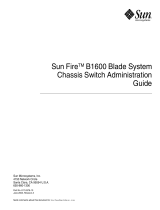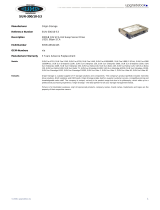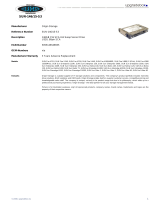Page is loading ...

Sun Microsystems, Inc.
www.sun.com
Submit comments about this document at: http://www.sun.com/hwdocs/feedback
Sun Netra
™
CP3000 Advanced
Mezzanine Card PCIe
Hard Drive and SAS Controller
User’s Guide
for the AMC.1-HDD SAS Disk
Part No. 820-7175-11
March 2010, Revision A

iii
Contents
Preface vii
1. Getting Started 1–1
1.1 System Requirements 1–2
1.1.1 Operating Systems Compatibility 1–2
1.1.2 Chassis Compatibility 1–2
1.1.3 Blade Server Compatibility 1–2
1.1.4 Electrical and Environmental 1–3
1.2 Unpacking 1–3
1.3 Handling AMCs 1–4
1.4 AMC Faceplate 1–5
1.5 AMC LEDs 1–6
1.6 Removing and Installing AMCs 1–8
1.6.1 Removing an AMC 1–8
1.6.2 Removing a Blade Server and AMC 1–12
1.6.3 Installing an AMC 1–13

iv Sun Netra CP3000 Advanced Mezzanine Card PCIe Hard Drive and SAS Controller User’s Guide • March 2010
1.7 Enabling and Disabling SAS Ports 1–18
▼ To Enable AMC Port 2 (Driven by Port 1 of SAS Controller) 18
▼ To Enable AMC Port 3 (Driven by Port 2 of SAS Controller) 18
▼ To Disable AMC Port 2 (Driven by Port 1 of SAS Controller) 19
▼ To Disable AMC Port 3 (Driven by Port 2 of SAS Controller) 19
2. Overview 2–1
2.1 Features 2–2
2.2 Key Components 2–3
2.2.1 Hard Drive Disk 2–3
2.2.2 Power Regulator 2–3
2.2.3 SAS Controller 2–4
2.2.4 Flash 2–4
2.2.5 Module Management Controller (MMC) 2–4
2.2.6 Port Connectors 2–5
2.2.7 LEDs 2–5
2.3 Faceplate and LEDs 2–5
2.4 Functional Diagram 2–7
2.5 Technical Support and Warranty 2–7
2.6 Part Number, Serial Number, and Revision Number Identification 2–8
2.7 Disposal 2–10
3. Managing the AMC 3–1
3.1 Monitoring and Control Functions 3–2
3.2 IPMI Controller 3–2
3.3 FRU Information 3–4
3.4 Sensors 3–5
3.5 Firmware and Software Upgrades 3–6

Contents v
4. Configuring the AMC 4–1
4.1 Configuration Tools 4–2
4.2 Boot BIOS Utility 4–2
4.2.1 Features and Configurations 4–3
4.2.2 Launching the Boot BIOS Utility 4–3
4.3 OpenBoot BIOS 4–5
4.4 Extensible Firmware Interface (EFI) BIOS 4–6
4.5 Enabling and Disabling Channel Ports 4–6
A. Connectors and Ports A–1
A.1 Connector Locations and Assignments A–2
A.2 Connector Pinouts A–2
A.3 SAS Controller Ports A–4
A.4 e-Keying Ports A–5
B. Environment Specifications B–1
B.1 Electrical and Environmental B–2
B.1.1 Electrical B–2
B.1.2 Environmental B–2
B.1.3 Absolute Maximum Ratings B–4
B.1.4 Normal Operating Ranges B–4
B.2 Reliability B–4
B.3 Mechanical B–5
B.3.1 Board Dimensions and Weight B–5
C. Agency Certifications C–1
C.1 CE Certification C–2
C.2 NEBS/ETSI C–2
C.3 Safety C–3
C.4 Emissions Test Regulations C–4

vii
Preface
The Netra™ CP3000 Advanced Mezzanine Card PCIe Hard Drive and SAS Controller
User’s Guide describes the installation and configuration of the Sun Netra CP3000
AMC.1-HDD SAS disk. This guide also includes information about software,
environment specifications, connectors, and certifications.
Typographic Conventions
Note – Characters display differently depending on browser settings. If characters
do not display correctly, change the character encoding in your browser to Unicode
UTF-8.
Typeface Meaning Examples
AaBbCc123 The names of commands, files,
and directories; on-screen
computer output
Edit your.login file.
Use ls -a to list all files.
% You have mail.
AaBbCc123 What you type, when contrasted
with on-screen computer output
%
su
Password:
AaBbCc123 Book titles, new words or terms,
words to be emphasized.
Replace command-line variables
with real names or values.
Read Chapter 6 in the User’s Guide.
These are called class options.
You must be superuser to do this.
To delete a file, type rm filename.

viii Sun Netra CP3000 Advanced Mezzanine Card PCIe Hard Drive and SAS Controller User’s Guide • March 2010
Related Documentation
The following table lists the documentation for the AMC.1-HDD SAS disk. The
online documentation is available at:
http://docs.sun.com/app/docs/prod/cp3000.pcie#hic
Third-Party Web Sites
Sun is not responsible for the availability of third-party web sites mentioned in this
document. Sun does not endorse and is not responsible or liable for any content,
advertising, products, or other materials that are available on or through such sites
or resources. Sun will not be responsible or liable for any actual or alleged damage
or loss caused by or in connection with the use of or reliance on any such content,
goods, or services that are available on or through such sites or resources.
Application Title Part Number Format Location
Latest
information
Sun Netra CP3000 Advanced Mezzanine Card PCIe
Hard Drive and SAS Controller Product Notes
820-7174-xx PDF Online
Pointer doc Sun Netra CP3000 Advanced Mezzanine Card PCIe
Hard Drive and SAS Controller Getting Started Guide
820-7177-xx Printed Shipping Kit
Installation
(this
document)
Sun Netra CP3000 Advanced Mezzanine Card PCIe
Hard Drive and SAS Controller User’s Guide
820-7175-xx PDF Online
Safety Important Safety Information for Sun Hardware Systems 816-7190-xx Printed Shipping Kit

Preface ix
Sun Welcomes Your Comments
Sun is interested in improving its documentation and welcomes your comments and
suggestions. You can submit your comments by going to:
http://www.sun.com/hwdocs/feedback
Please include the title and part number of your document with your feedback:
Sun Netra CP3000 Advanced Mezzanine Card PCIe Hard Drive and SAS Controller User’s
Guide, part number 820-7175-11.

x Sun Netra CP3000 Advanced Mezzanine Card PCIe Hard Drive and SAS Controller User’s Guide • March 2010

1-1
CHAPTER
1
Getting Started
This chapter provides information and procedures needed to install and make the
Sun Netra CP3000 AMC.1-HDD SAS disk operational. This chapter should be read
before unpacking and installing the AMC.
In addition to this chapter, refer to the following safety document:
Important Safety Information for Sun Hardware Systems (816-7190)
Caution – When the system is plugged in, energy hazards are present on the
midplane. Do not reach into the enclosure while the power is on.
Caution – Static electricity can damage electronic components. Wear a wrist strap
grounded through one of the system’s ESD ground jacks when removing and
replacing hot-swappable components.
This chapter contains the following topics:
■ Section 1.1, “System Requirements” on page 1-2
■ Section 1.2, “Unpacking” on page 1-3
■ Section 1.3, “Handling AMCs” on page 1-4
■ Section 1.4, “AMC Faceplate” on page 1-5
■ Section 1.5, “AMC LEDs” on page 1-6
■ Section 1.6, “Removing and Installing AMCs” on page 1-8
■ Section 1.7, “Enabling and Disabling SAS Ports” on page 1-18

1-2 Sun Netra CP3000 Advanced Mezzanine Card PCIe Hard Drive and SAS Controller User’s Guide • March 2010
1.1 System Requirements
The following sections briefly describe the minimum system requirements and the
configurable features. Links are provided to other chapters and appendixes
containing more detailed information.
1.1.1 Operating Systems Compatibility
The following operating systems are compatible with the AMC.1-HDD SAS disk.
■ Solaris™ 10
■ Solaris x86 10
■ Windows Server 2003
■ Red Hat Enterprise Linux (RHEL) 5
1.1.2 Chassis Compatibility
Before using this AMC.1-HDD SAS disk, review the specifications of the chassis and
backplane that will house the module to determine the presence of, and any
limitations of, chassis, IPMI bus, and user-defined pin-outs. For example, some
chassis backplanes route certain I/O pins to internal resources such as alarm cards
and drive resources. The AMC.1-HDD SAS disk is intended for an AdvancedTCA
AMC carrier card site that is AMC.1 compliant. It is your responsibility to verify
system compatibility. Failure to do so could result in improper operation or
equipment damage.
1.1.3 Blade Server Compatibility
The AMC.1-HDD SAS disk modules plug into ATCA carrier boards that support a
combination of AMC.1 (PCI Express) and AMC.3 (SAS) storage signaling.
At the time of publication of this document, the AMC.1-HDD SAS disk is qualified
and supported on the following Sun blade servers:
■ Sun Netra CP3060 blade server
■ Sun Netra CP3220 blade server
■ Sun Netra CP3250 blade server

Chapter 1 Getting Started 1-3
1.1.4 Electrical and Environmental
See Appendix B for electrical and environmental requirements.
Caution – None of the integrated chips junction temperature should exceed 125˚C.
The AMC requires air flow to meet this requirement. Testing should be done in the
shelf to find the quantity of air flow needed. The recommended minimum air flow is
50 LFM.
1.2 Unpacking
Check the shipping carton for damage. If the shipping carton or contents are
damaged, notify the carrier and Sun. Retain the shipping carton and packing
material for inspection by the carrier. Obtain authorization before returning any
product to Sun. Refer to the Netra CP3000 Advanced Mezzanine Card PCIe SAS
Controller and Hard Drive Getting Started Guide (820-7177) for return instructions.
Caution – This board must be protected from static discharge and physical shock.
Never remove any of the socketed parts except at a static-free workstation. Use the
antistatic bag shipped with the product to handle the board. Wear a wrist strap
grounded through one of the system's ESD ground jacks when installing or servicing
system components.

1-4 Sun Netra CP3000 Advanced Mezzanine Card PCIe Hard Drive and SAS Controller User’s Guide • March 2010
1.3 Handling AMCs
Caution – The system is sensitive to static electricity. To prevent damage to the
assembly, always connect an antistatic wrist strap between you and the system.
Avoid touching areas of integrated circuitry. Static discharge can damage these
circuits.
An antistatic wrist strap and a conductive foam pad is strongly recommend for
handling AMCs when installing or upgrading a system. Electronic components, such
as disk drives, computer boards, and memory modules can be extremely sensitive to
electrostatic discharge (ESD). After removing the component from its protective
wrapper or from the system, place the component flat on a grounded, static-free
surface (and, in the case of a board, component side up). Do not slide the component
over any surface.
If an ESD station is not available, you can avoid damage resulting from ESD by
wearing an antistatic wrist strap (available in the shipkit and at electronics stores)
that is attached to an active electrical ground. Note that a system chassis might not
be grounded if it is unplugged.
Caution – Dangerous voltages, capable of causing injury or death, are present in
this equipment. Use extreme caution when handling, testing, and adjusting within a
system.
Caution – Do not flex the AMCs; the surface-mounted components can break if the
AMC is bent.
Our suppliers take significant steps to ensure that there are no bent pins on the
backplane or connector damage to the AMCs prior to leaving the factory. Bent pins
caused by improper installation or by AMCs with damaged connectors could void
the warranty for the backplane or boards.
To minimize the amount of AMC flexing, observe the following precautions:
■ When removing an AMC from an electrostatic discharge bag, keep the AMC
vertical until you place it on the electrostatic discharge mat.
■ Do not place an AMC on a hard surface. Use a cushioned antistatic mat. The
AMC connectors and components have very thin pins that bend easily.
■ Be careful of small parts located on the component side of an AMC.

Chapter 1 Getting Started 1-5
■ Do not use an oscilloscope probe on the components. The soldered pins are easily
damaged or shorted by the probe point.
■ Transport an AMC in an antistatic bag.
1.4 AMC Faceplate
The following shows the faceplate of the Sun Netra CP3000 AMC.1-HDD SAS disk.
FIGURE 1-1 AMC.1-HDD SAS Disk Faceplate
Note – The AMC is available in different capacities (in gigabytes). The illustration
shows a generic faceplate. For your product’s faceplate, the xxx denotes the capacity.

1-6 Sun Netra CP3000 Advanced Mezzanine Card PCIe Hard Drive and SAS Controller User’s Guide • March 2010
1.5 AMC LEDs
The following tables give status information for all of the LEDs on the AMC.
TABLE 1-1 describes the LEDs defined by ATCA to monitor board status.
TABLE 1-2 describes in detail the different hot-swap BLUE LED states.
TABLE 1-1 AMC Status LEDs
LED Color State Description
Hot-swap Blue On Management power is available to the AMC, and
the AMC can safely be extracted.
Off The AMC is operational and is unsafe for
extraction.
Long blink Delay before AMC is activated.
Short blink Delay before AMC is deactivated.
OOS Red Off AMC is in service.
On Light is on when AMC is Out Of Service.
OK Green On The AMC is booted and switching.
Off 12V payload power is not detected.

Chapter 1 Getting Started 1-7
Note – An AMC should be hot-swapped only when the LED is solid blue.
TABLE 1-2 Hot-Swap BLUE LED States
Order Visible State State Description
1 Solid M1 FRU Inactive The Intelligent Platform
Management Interface (IPMI)
microcontroller is booted, but the
payload is not. The bottom latch is
not fully closed or the activation
lock bit set is keeping AMC from
activating.
2 Blinking (from solid) M2 Activation
Request
The bottom latch is closed or
activation lock bit has been cleared.
The IPMI microcontroller has
requested permission to boot the
payload from the shelf
management controller.
3 Off M3-M4 Active The IPMI microcontroller has
received permission to activate the
payload, and has done so. This
should be the state under normal
operation.
4 Blinking (from off) M5-M6
Deactivation
Request
The IPMI microcontroller has
requested permission to deactivate.
Opening the bottom latch or
resetting the deactivation lock bit
activates this state.

1-8 Sun Netra CP3000 Advanced Mezzanine Card PCIe Hard Drive and SAS Controller User’s Guide • March 2010
1.6 Removing and Installing AMCs
This section describes how to remove and install AMCs.
The AMC.1-HDD SAS disk can be installed into an ATCA shelf (chassis) with sites
that support AMC.1 PCI Express signaling. The site height must properly match the
panel height fitted to the AMC.
At the time of publication of this document, the AMC.1-HDD SAS disk is qualified
and supported on the following Sun blade servers:
■ Sun Netra CP3060 blade server
■ Sun Netra CP3220 blade server
■ Sun Netra CP3250 blade server
1.6.1 Removing an AMC
If you want to remove only an AMC from a blade server, use the following
instructions.
If you want to remove the blade server with the AMC installed, see the next section
Section 1.6.2, “Removing a Blade Server and AMC” on page 1-12.
Caution – Before removing an AMC, read all cautions, warnings, and instructions
presented earlier in this chapter.
1. Shut down the payload OS.
Removing a board before powering down the operating system might cause an
OS panic, which could corrupt data or file systems.
2. At the front of the blade server, locate the AMC you want to remove.
Depending on the blade server’s AMC site location, you might have to remove
the blade server from the chassis. Some blade servers have compartments for
AMCs that can only be accessed when the blade server is removed from the
chassis.
3. If the blade server must be removed to access the AMC, go to Section 1.6.2,
“Removing a Blade Server and AMC” on page 1-12.

Chapter 1 Getting Started 1-9
Note – Depending on how the Shelf controls deactivation, the Shelf might not
initiate deactivation when you disengage the ejector latch. If so, either configure the
Shelf to allow deactivation via latch opening or deactivate by other methods.
4. For the AMC, initiate the hot-swap deactivation sequence by pulling the
injector/ejector latch out half way (
FIGURE 1-2).
The Hot-Swap LED starts blinking.
5. Wait until the Hot-Swap LED is solid blue.
6. When the Hot-Swap LED is solid blue, pull the injector/ejector latch out
completely (
FIGURE 1-2).

1-10 Sun Netra CP3000 Advanced Mezzanine Card PCIe Hard Drive and SAS Controller User’s Guide • March 2010
FIGURE 1-2 Deactivating the AMC
Figure Leg end
1 Fully In (IN) When IN, the module communicates to the shelf manager that the module is not in the
hot-swap state, and the shelf manager communicates with the MMC. This position is for normal
operation.
2 Half Way (HW) When in the HW position, the hot-swap sequence is initiated. The MMC sends a
hot-swap event to the shelf manager.
3
Out (OUT) When OUT, the latching mechanism is released and the module can be extracted. Wait
for the Hot-Swap LED to stop blinking before pulling the latch all the way out.
/




